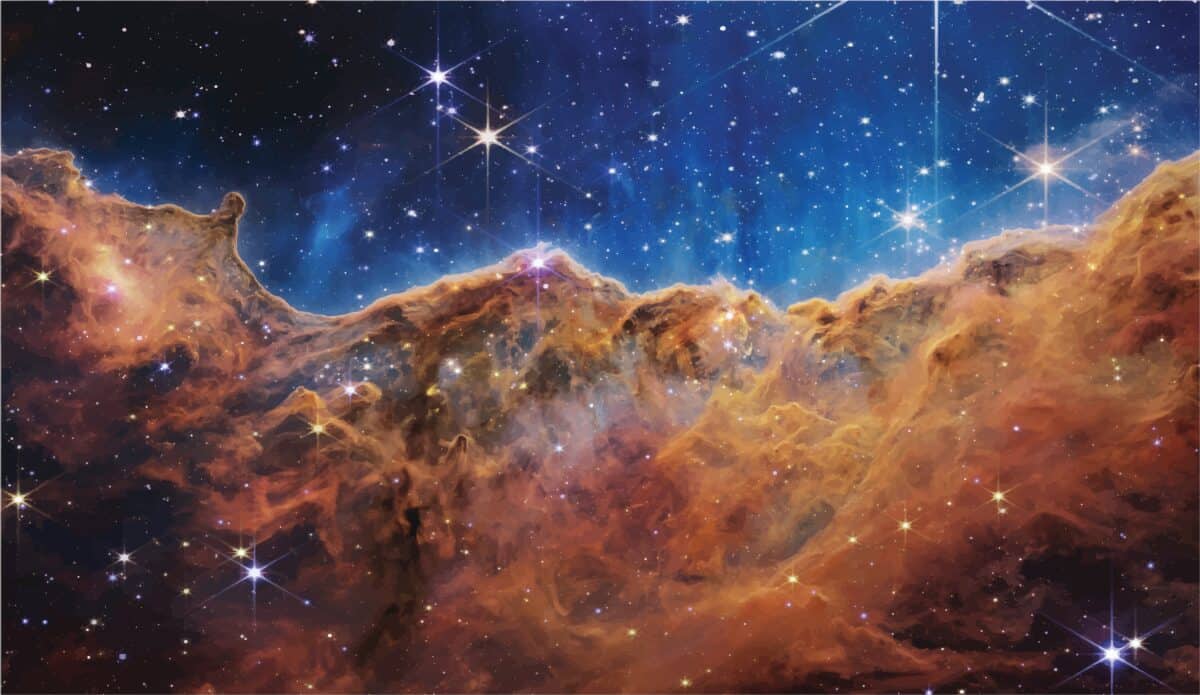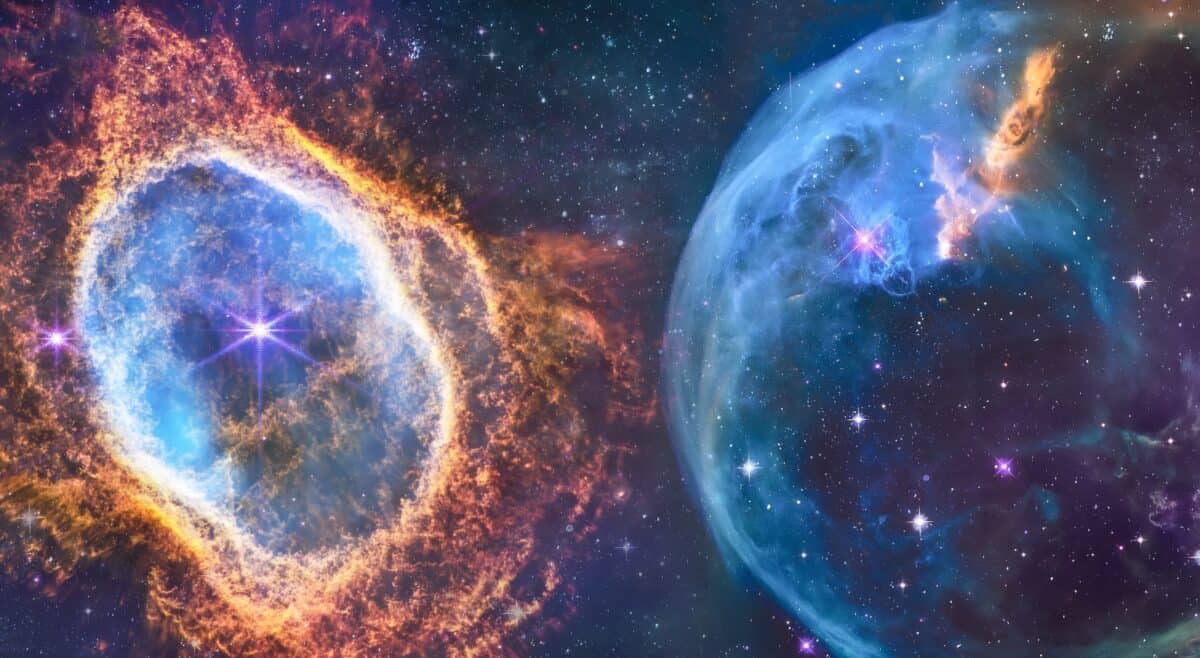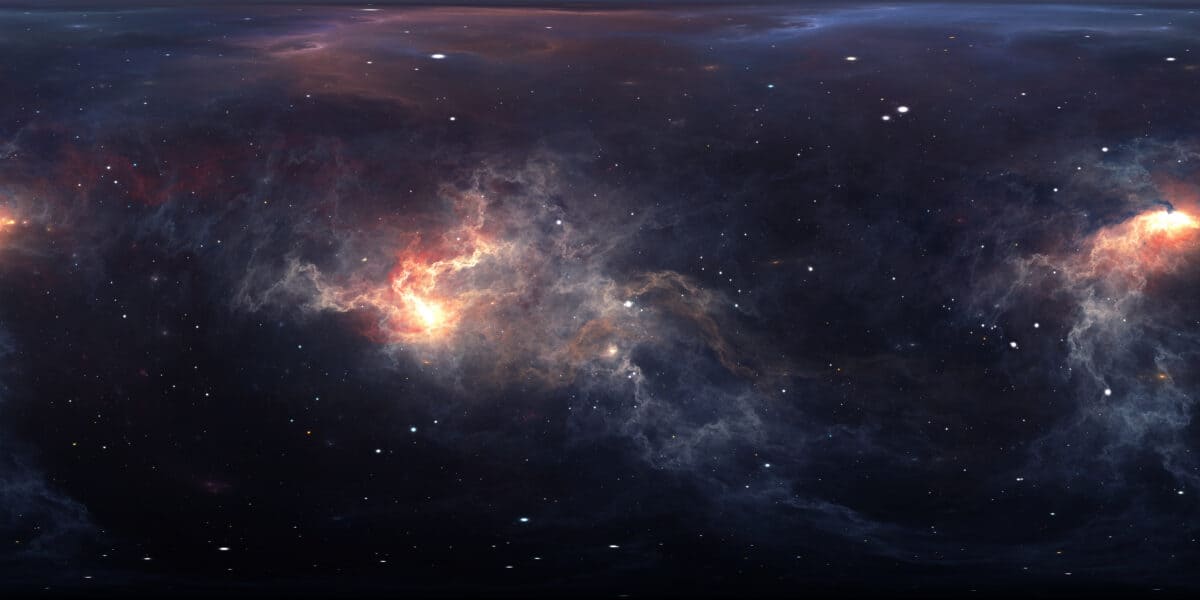The James Webb Telescope (JWST) is the largest telescope ever built. The images from the JWST are mind-blowing and reshape much of what we know about our universe. Would you like to time travel? The James Webb Telescope is peering into the furthest regions of our universe.
The deeper we look into the universe, the further back in time we’re traveling. The James Webb Telescope allows us to look 13.5 billion years into the past. Let’s look at mind-blowing James Webb telescope facts for space geeks.
What’s the Purpose of the James Webb Telescope?
NASA identified four primary scientific objectives for the Jame Webb Telescope:
- Look back in time, 13.5 billion years to be exact, to the formation of the first galaxies and stars after the big bang.
- Learn how galaxies assemble over time (billions of years).
- Use infrared vision to look through dust clouds and see where stars and planets are born.
- Study the atmosphere of extrasolar planets. Do other planets have the building block of life too?
To understand how the James Webb Telescope can look billions of years into the past, we need to understand distances and light travel in relationship to space.
Distances Within Our Solar System
We (non-astronomers) use miles or kilometers to discuss distances within our solar system. It’s 239,000 miles from the Earth to the Moon. That’s easily understandable.
New Horizons, the fastest rocket (to date), travels at approximately 36,000 miles per hour.
- So just how long would it take for New Horizons to reach the moon (239,000 miles)? It will take approximately 6.5 hours to get there.
- If we send New Horizons to Pluto, our crazy close next-door neighbor (3,577,000,000 miles), it will take 11 years inside the New Horizons.
Fun fact: If we send our fastest fighter jet (Lockheed YF-12A) to the Moon at its fastest speed of 2,275 Miles Per Hour (MPH), it will take approximately four and a half days. If we drive to the Moon (assuming we’re in Texas and drive 85MPH), it will take around 117 days.
Light Years

©cometa geo/Shutterstock.com
The distances are so vast that using “earthly” measurements makes no sense. Proxima Centauri is our closest “star neighbor” at 25,300,000,000,000 miles.
If we jump into our car and start driving towards Proxima Centauri, we should arrive in approximately fourteen million years. (Better bring a snack!)
The distances and times become too big for easy digestion, so instead of miles per hour, we use a light year as a measurement.
How Fast Does Light Travel?
Light travels at 186,000 miles per second, approximately 5.88 trillion miles per year. If we look at Proxima Centauri, we can use light years as a measurement standard and say that it’s about four light years away from Earth.
#1: The James Webb Telescope Looks Into the Past
The James Webb Telescope (JWST) can peer about 13.6 billion light years into the past. How does that work?
- When sunlight reaches Earth, the sunlight leaves the sun about 499 seconds before it arrives on Earth. Four hundred ninety-nine seconds (8.3 minutes) to travel 93,000,00 miles. The same principle is true when we look at galaxies and stars outside our solar system. The light we’re looking at right now began its journey across space a very long time ago.
- If examining a signal, or light, that left a different galaxy 13.6 billion years ago, we’re peering into the past. (Fun fact: The light we’re looking at today, 13.6 billion years after it left its galaxy, is not necessarily the same light that exists today at the source of the light. The light source itself may have burned out billions of years ago!)
#2: James Webb Telescope vs Hubble: Same, Same, but Different
There was a great deal of discussion in the scientific community that the JWST was a replacement for the Hubble Telescope. The two telescopes have different and overlapping capabilities. The real power of the two instruments may be in collecting data from the same object and then comparing the two.
Hubble Versus JWST

©Dima Zel/Shutterstock.com
The JWST has different instrumentation than the Hubble Telescope. The Hubble is designed with an eye toward optical and ultraviolet wavelengths. Infrared wavelengths are JWST’s bread and butter.
| Hubble Telescope | James Webb Telescope | |
|---|---|---|
| Wavelength Range | 200nm-2.4um* | 600nm – 28um* |
| Primary Mirror | 7.9 ft/50ft2 | 21.7ft /270ft2 |
| Orbits (Keep it cold!) | 332 miles | 1,000,000 miles |
#3: James Webb Telescope: Primary Mirrors-18!
Telescopes are all about mirrors. Bigger mirrors can collect “fainter” light. Bigger is better.
Hubble Primary Mirror
- The Hubble has one primary mirror. Initial mages were defocused and distorted. NASA corrected the image distortion several years later with a new mission to Hubble.
- The Primary mirror has approximately 50 ft2 of surface collection area.
- The location of the Hubble made a “fix” possible.
JWST Segmented Primary Mirrors
- The JWST is the first space telescope to use segmented primary mirrors. The primary mirror is composed of 18 hexagon-shaped mirrors.
- The mirrors are made from beryllium and coated with gold.
- Each mirror is 4.3ft in diameter. The JWST has 270ft2of a surface collection area.
- The primary mirror is structured similarly to a drop leaf table:
- The main section of the “table” is in the center,
- One leaf at each end of the table,
- Each leaf is foldable behind the table.
- During launch from Earth, the (leaf) mirrors folded inward so that the entire structure would fit inside an Ariane 5 rocket.
- Six days after launch, the wing mirrors were unfolded from behind the main mirror (table) and positioned next to the main mirror (table).
- Each hexagon mirror has seven actuators for fine and coarse position adjustments.
- After each mirror is individually adjusted, the result is a single mirror surface that acts as a perfect reflector.
#4: James Webb Telescope Is Orbiting a Long Distance Away
The JWST is in orbit approximately 1,000,000 miles from Earth in the location known as the L2 Lagrange. The L2 Lagrange is an excellent location to “park” a telescope to collect deep space images without interference from Earth. (The Hubble is orbiting the Earth at approximately 330 miles above the planet’s surface.)
Let’s consider why we want to place a telescope in the L2 Lagrange.
L2 Lagrange (General Three-Body Problem)

©Dima Zel/Shutterstock.com
A Lagrangian point is a location in space where the object’s orbital motion (telescope) and gravitational forces (sun and moon) balance each other out. The L2 Lagrange point allows the JWST to use very little power (thrusters) to remain in the exact relative location.
The L2 Lagrange point is basically a parking lot in space. Objects move “around” in the L2 area, but only minor adjustments are required to keep them positioned correctly.
Fun fact: Of the five Lagrange points in our solar system, L3 is behind the Sun, so we never see it. Could another planet exist that we never see? Science fiction writers explore L2, and science writers explore gravitational theory in conjunction with computational physics.
The L2 Lagrange point (there are five) is a good location for turning telescopes “back” to the Earth and Sun to block heat while opening up a tremendous forward view of deep space. JWST has done this.
#5: Heat Shield on the James Webb Telescope Is Insanely Technical
There’s a crazy amount of engineering that went into the JWST’s heat shield. The JWST infrared measurement equipment provides the most accurate data when its component temperature is -364℉. It’s no small feat to reach that temperature. There are two primary methods used to reach this chilly temperature.
Passive Cooling: A Heat Shield
A heat shield, shaped like a football and the size of a tennis court, is extended behind the telescope. The heat shield weakens the heat of the Sun about one million times from the outside of the “outer” layer (layer 1) to the “inside” of the inner layer (layer 5).
| Material/Thickness | Coating | Temp (hot/cold side) | |
|---|---|---|---|
| Layer 1 | Kapton 0.050mm | Al/100nn, Si/50nm | 231°F |
| Layer 2 | Kapton 0.025mm | Al/100nn, Si/50nm | |
| Layer 3 | Kapton 0.025mm | Al/100nn | |
| Layer 4 | Kapton 0.025mm | Al/100nn | |
| Layer 5 | Kapton 0.025mm | Al/100nn | -80°F/-394°F |
- Sunlight strikes Layer 1 (outer layer). Layer 1 is “aimed” at the Sun/Earth. Some heat is absorbed, some is reflected, and some is passed onto Layers 2, 3, 4, and 5.
- The heat decreases on each successive layer of the heat shielding.
- Each heat-shielding layer is slightly angled “off” the previous layer so that reflected heat is moved/bounced “out’ of the reflectors and not absorbed by the next layer of Kapton.
#6: A Cryocooler on the James Webb Telescope in Space
Passive cooling keeps the temperature low enough for three (of four) scientific instruments to work correctly. The Mid-Infrared Instrument (MIRI) requires a temperature of approximately -447°F.
A cryocooler cools the MIRI to the proper operating temperatures. In a closed-loop system, passively cooled helium passes through a Joule-Thomson value. The helium decreases in temperature due to the Joule-Thomson effect. The helium reaches a temperature of about -449°F.
The cooled helium passes by a copper block attached to the MIRI detector. Heat exchange between the detectors and copper block brings the temperature of the MIRI detector down to cold enough for the operation.
#7: Whoa! Why Does It Have to Be So Cold?
Other telescopes don’t need temperatures this cold. Why does JWST require such cold temperatures?
Suppressing Its Own Heat Signature
The MIRI collects infrared data, or heat data. Suppose the operating temperature of the hardware surrounding the MIRI is too high. In that case, the MIRI will collect data from the instrument’s heat rather than the object’s infrared data in space.
Dark Current Suppression
Dark current detection causes the detector to respond as if it received an actual signal. It didn’t. Dark currents are the vibrations of atoms located inside the actual sensor itself. Atoms move (vibrate) slower at colder temperatures.
Lower temperatures equate to reduced atom movement, which equals less dark current. Less dark current equals fewer false signals. MIRI detects long infrared wavelengths that make it highly susceptible to Dark Currents.
#8: Looking Through the Dust and Clouds

©Jurik Peter/Shutterstock.com
The shorter infrared vision of the JWST provides an opportunity to see “through” massive clouds of dust and gas. Stars and planetary systems are formed behind the clouds. This ability is a key feature of the JWST. It’s a HUGE deal.
We need to look at the Electromagnetic spectrum to understand how the JWST can see “through” the clouds.
Electromagnetic Spectrum
The electromagnetic spectrum (EM) is all types of energy/ radiation. The visible light spectrum — the wavelengths we can see with our eyes — is a tiny fraction of the entire EM spectrum. Seven different wavelength categories exist in the electromagnetic spectrum.
| Wavelength | Example | |
|---|---|---|
| Radio Waves | > 1 mm | Broadcast radio/ TV |
| Microwaves | 1 mm – 25 μm | Cellphones, radar, cooking |
| Infrared | 25 μm – 2.5 μm | Transmitted heat from radiators, the sun, fire |
| Near-Infrared | 2.5 μm – 750 nm | |
| Visible Light | 750 nm – 400 nm | What your eyeballs see! |
| Ultraviolet | 400 nm – 1 nm | Tanning beds, sunshine |
| X-Rays | 1 nm – 1 pm | Medical, airport |
| Gamma Rays | < 10-12 m | Kill cancer cells, irradiate food |
Infrared Spectrum
The Hubble observes light at primarily optical and ultraviolet wavelengths. The human eye can “see” in the visible light spectrum.
The JWST is designed to detect primarily infrared light. Humans can’t “see” Infrared wavelengths.
The JWST is designed for the infrared collection. Visible light has a shorter wavelength than infrared. The longer wavelength of infrared allows it to travel through thick dust/ gas areas with less light scattering and refraction. Shorter wavelengths, like visible light, have much more dispersion and refraction.
- Example: Think of infrared as the “introvert” at a crowded party. The infrared will slip in through the front door and out the backdoor without too many interactions. The visible light, the extrovert, will bounce around and have many interactions.